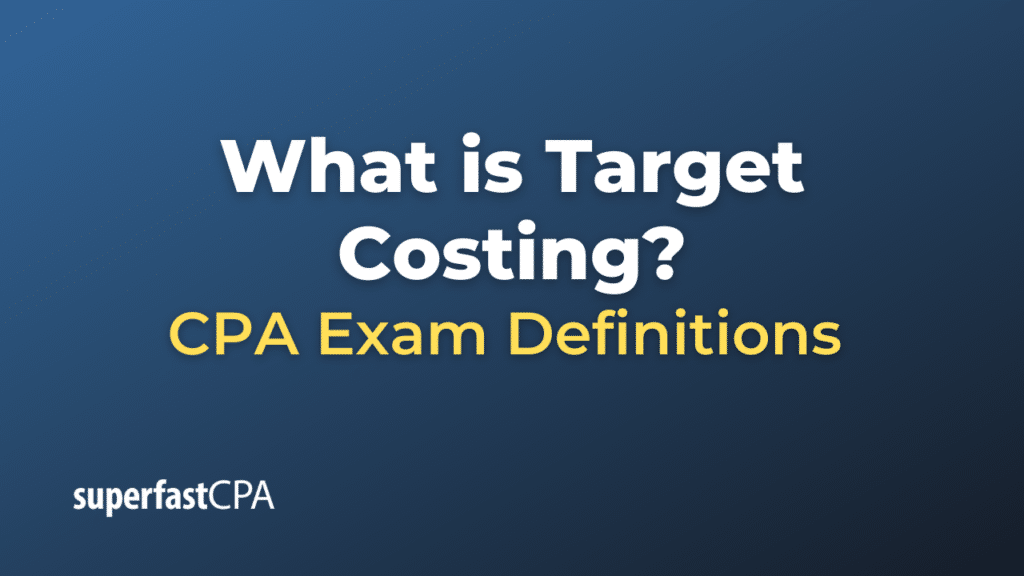Target Costing
Target costing is a pricing strategy in which a company determines the desired selling price of a product first, and then subtracts the desired profit margin to find the target cost. After determining the target cost, the company will then aim to produce the product at this cost by analyzing and, if necessary, reducing costs throughout the product’s lifecycle.
The steps in target costing can be summarized as follows:
- Determine the Desired Selling Price: Research the market to understand what customers are willing to pay for the product or service. This involves analyzing competitors’ prices, customer preferences, and other market dynamics.
- Subtract the Desired Profit Margin: This gives the target cost for producing the product.
- Calculate the Current Production Cost: This is the actual cost to produce the product based on current processes, suppliers, and materials.
- Identify Cost Reduction Opportunities: If the current production cost is higher than the target cost, the company needs to identify ways to reduce costs. This could involve optimizing processes, renegotiating with suppliers, using different materials, or redesigning the product.
- Implement Cost Reduction Strategies: After identifying opportunities, the company will implement strategies to achieve the target cost.
- Review and Monitor: The company will continuously monitor costs and make adjustments as necessary to ensure that they remain in line with the target cost.
The target costing method is particularly popular in highly competitive industries where there’s little differentiation between products and customers are sensitive to price changes, such as the automotive and electronics industries. The strategy emphasizes proactive cost control and constant innovation to keep costs down, rather than just setting prices based on current production costs.
Advantages of target costing include a stronger focus on the customer (since the desired selling price is based on market research), potential for higher profit margins (by actively seeking to reduce production costs), and fostering a culture of cost awareness and innovation throughout the company.
However, challenges can arise if the target costs are set too aggressively, which might lead to compromises in product quality or strain relationships with suppliers.
Example of Target Costing
Let’s use the automotive industry as an example, as it’s one of the sectors where target costing is commonly employed.
Scenario: XYZ Auto Corp. wants to release a new sedan to compete in the mid-tier automobile market segment.
Step 1: Determine the Desired Selling Price Through market research, XYZ Auto Corp. discovers that most vehicles in this segment sell between $25,000 and $30,000. To remain competitive, they decide on a desired selling price of $27,500 for their sedan.
Step 2: Subtract the Desired Profit Margin XYZ Auto Corp. wants a profit margin of $5,000 per vehicle sold. Therefore, the target cost to produce each sedan should be: $27,500 (selling price) – $5,000 (profit) = $22,500.
Step 3: Calculate the Current Production Cost Upon assessing their current production capabilities, materials, and processes, XYZ Auto Corp. finds out that producing the sedan with the features they envisioned would actually cost $24,000.
Step 4: Identify Cost Reduction Opportunities Given the discrepancy of $1,500 between the target and current production costs ($24,000 – $22,500), the company must find ways to reduce costs. They consider:
- Negotiating bulk deals with parts suppliers.
- Using alternative materials that are cheaper but maintain quality.
- Improving manufacturing processes to reduce waste.
- Integrating more automation to reduce labor costs.
Step 5: Implement Cost Reduction Strategies After negotiations and process adjustments, XYZ Auto Corp. successfully reduces its production cost by $1,200. The new production cost is now $24,000 – $1,200 = $22,800. This is still $300 above their target, but it’s closer to the goal.
Step 6: Review and Monitor Once the sedan hits the market, XYZ Auto Corp. continuously monitors production costs, looking for additional cost-saving opportunities. They also track customer feedback to ensure that the cost-cutting measures haven’t negatively impacted the product’s quality or market perception.
In this scenario, XYZ Auto Corp. uses target costing to make their sedan competitive in the market while striving to maintain their desired profit margin. This method ensures they remain cost-conscious and customer-focused throughout the vehicle’s development and production phases.













